INTRO:
Ever since Binding of Isaac, there has been an interest in rogue-lite games that reward skill on the part of the player while minimizing the influence of luck on the gameplay. Nuclear Throne appears to scratch that itch (if the DLCs for and sequel to Binding of Isaac have not already). Unfortunately, a design decision on the part of Vlambeer prevents the player from fully utilizing his/her skill and experience at this game.
PREMISE:
The post-apocalypse is a staple setting in video games. However, where most games that use this setting are often serious in their tone (most of the time), Nuclear Throne has a whimsical take on it. Of course, this is perhaps expected, since Vlambeer – maker of the goofy shooter Gun Godz – developed this game.
The world in Nuclear Throne has gone down the atomic toilet. Whatever remains of humanity are now comically hideous mutants that have no qualms mutating themselves in order to survive. Glowing-green radioactive materials are the new currency (and also food), and language has devolved into “Trashtalk”, which is practically gibberish with actual meaning behind every utterance.
Also, many, many guns have survived the nuclear holocaust, so everyone that has hands (or equivalents) is well-armed.
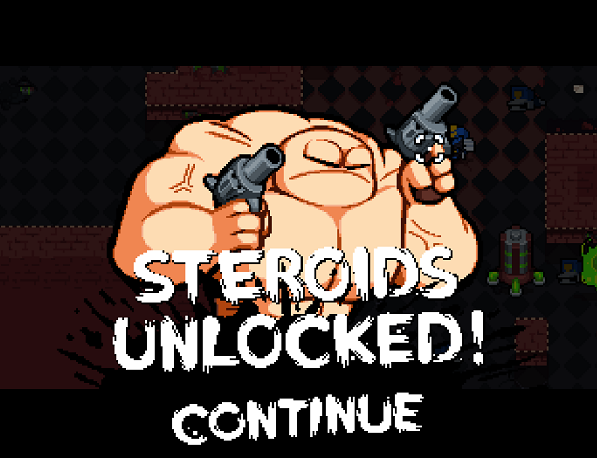
Life is understandably harsh and short for anyone, including the mutants. However, there is a pervasive rumor about a chance at hope: the titular Nuclear Throne. The rumor is that anyone who controls the throne controls the fate of the world – but there can be only one. Further bolstering this rumor, anyone who seeks the Nuclear Throne would be stalked by semi-sentient portals that shunt them closer and closer to the abode of the Throne.
Predictably, this results in there being quite a lot of hazards, monsters and murderous competitors along the way. The protagonist – whoever and whatever he/she/it is – has to destroy the others in order to advance. Furthermore, there are inter-dimensional cops that seem to be interested in anyone pursuing the Throne – and this interest is expressed through filling their target with plasma.
PLAYER CHARACTERS:
According to the speculation of fans and some tidbits by Vlambeer’s people, the player characters have made a pact with each other in their pursuit of the Nuclear Throne: they will set out for it, one person at a time, piece-meal. This seems silly and counter-productive, but after the player has played the game and observed the level layouts, this is probably for the better. Otherwise, they would just get into each other’s way.
Anyway, the player starts with three characters, all of whom are mutants and one of which is purportedly a survivor from before the apocalypse. There are far more characters than just these three (and more than just mutants), but they have to be unlocked by fulfilling specific conditions.
(Incidentally, there had been some “joke” characters that were temporarily added to the Steam version of the game, such as one of the large bosses being made playable.)
Most of the player characters have the same basic capabilities, e.g. moving about and shooting guns. Their special abilities make them unique, however. These will be described later, after more important things have been elaborated.
HIT POINTS:
In single-player mode, a run in Nuclear Throne ends when the player character’s HP is reduced to zero. Most player characters start with eight HP, but there are others that start with less HPs.
Attacks from enemies, if they land, can deal damage that range from a manageable one hitpoint to a possibly fatal five hit points. Without referring to the wiki for the game, the player will have to learn the hard way how much damage can be inflicted by a kind of attack from an enemy. Of course, there is still a rule of thumb to this matter: if an enemy attack looks particularly flashy or it involves huge projectiles, it is likely to hurt more.
The player character’s hitpoints are not on a one-way trip to zero. Enemies sometimes drop med-kits, there are mutations that can heal, and sometimes loot chests are replaced with large med-kits, if the player character is particularly hurt. In fact, the probability of these healing sources occurring gets higher as the player character’s hitpoints get lower.
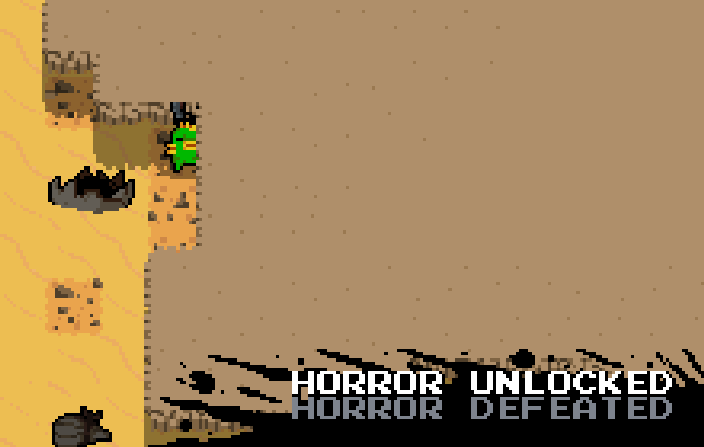
AMMUNITION:
There are five types of ammunition: Bullets, Shells, Energy, Explosives and Bolts. The guns in the game can be given broad categorizations based on the ammunition that they use. However, there are cases in which a gun that uses the same ammunition as another gun can work very differently from the other gun.
It is important to stock ammunition of any kind. Running out of ammunition for both of the player character’s guns (if both weapons are guns) and for any guns that happen to be lying around means that the player character is very much screwed. After all, there is no fall-back weapon in this game.
However, there are limits to the amounts of ammunition that a player character can stock. Therefore, the player might want to consider switching guns for other guns if the ammunition for the current guns is running dry.
AMMO PICK-UPS:
There is a chance that a slain enemy may drop ammo-replenishing items; if they happen to be armed, they are likelier to do so.
These items will disappear in several seconds, however. Unless the player character has the mutation that sucks in dropped items, he/she/it has to move over the items in order to collect them. Considering how important it is to remain topped up on ammunition, dropped ammo items are a good incentive to keep moving – or at least dart out of cover for a while before hoofing it back.
AMMO CHESTS:
At least one yellow/orange chest appears in just about every level. This contains a considerable amount of ammo of one type, usually the type that the player character’s guns use. This is convenient if the player is running dry on ammo, and unlike ammo dropped by enemies, an ammo chest can stay in a level indefinitely, like other chests.
RADS:
Rads are radiation in solid, tangible form. They are a source of real power to the player characters. After collecting enough Rads, a character gains a level; the progress towards this is shown in the meter at the upper left corner of the screen.
Rads are gained primarily through killing enemies: slain enemies drop rads, which have to be collected before they disappear after a few seconds. Fortunately, rads are attracted to the player character, who vacuum them in if he/she/it is a short distance away. A certain mutation makes it possible to get rads from much further away, but the rads are solids that will get caught on obstacles, if there happen to be any in their way.
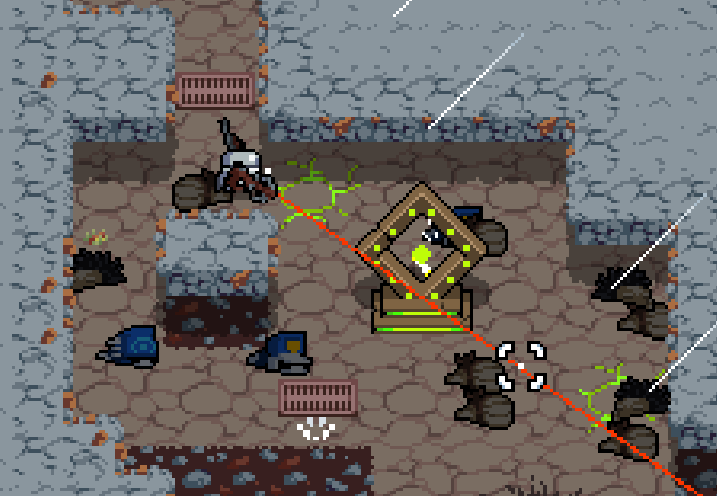
Considering how important it is to gain levels in order to maintain the competitiveness of the player character against increasingly stronger and more numerous enemies, rads are the main reason that the player would have for having a player character break cover. The disappearing rads also become the main reason for long-range off-screen kills being impractical, even though it may be tactically wise to resort to these.
LEVELS:
After the player character has collected enough rads, he/she/it gains a level. Every level grants the opportunity to select a ‘mutation’; mutations will be described further later, but suffice to say for now that the mutations strengthen the player character.
Player characters can only go up to level 10, meaning that the player has to be careful about his/her choices.
After that, any rads that are collected merely go into a counter, but will not be consumed for level-ups. However, when this happens, the player would likely be consuming rads for the use of Ultra-class weapons; these will be described further later. There are also some characters with special abilities that consume rads.
SPECIAL ABILITIES:
The game splits special abilities into two major groups: the “active” ones, which are in the player’s control, and the “passive” ones, which are not in the player’s control but either have conditional triggers or are ever-present modifiers.
ACTIVE ABILITIES:
Active abilities are triggered with a control input. Each character has one, which is different enough from the others to be almost unique. However, there are still some similarities; this might help players who want to stick to certain playstyles.
Some special abilities are evasive moves. There is Fish’s combat roll, which he retained from his years as a (presumably) human cop. The special ability of another character, Crystal, gains an evasive property when it is upgraded; the player character can teleport to another location. These characters would be good for players who prefer to just not be there when an attack lands.
There are special abilities that fire the player character’s weapons, usually for some additional benefit. Yung Venuz (Y.V.) shoots his gun twice simultaneously, but this also delays his next shot and the two-shot attack (officially called “Pop-Pop”) has slightly reduced accuracy. Chicken does not fire her weapon, but throws it instead. Steroids simply shoots both his guns, but is quite bad at aiming. Skeleton (which is actually Melting, but with different powers) can fire its gun without using any ammo, but at the risk of hurting itself.
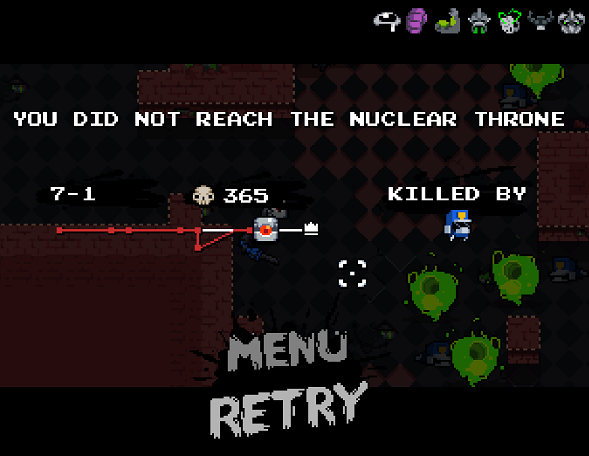
There are special abilities that exploit the fact that enemies are never aware of nearby hazards. Plant’s ability is the most notable of these; it creates a snare that can greatly slow down just about any enemy that steps into it. Plant can only maintain a single snare (or a cluster of closely-packed snares) at any time, but the snare can affect multiple enemies, if they are not too big. Next, there is Melting’s corpse explosion ability, which works much like the same ability in the classic Diablo 2.
There are special abilities that have their own resource concerns. Horror’s rad vomit expels rads from the rad counter, though they can be retrieved, if the player character can get close to them. Rogue’s special ability uses an ammunition that is unique to her, and which only spawns if she is around; this is just as well, because her Portal Strike is quite devastating. Rebel’s special ability consumes her hitpoints, but she spawns henchmen (though they could very well be her children) that do not draw fire from enemies.
Eyes’ telekinetic powers require considerable finesse to use. It causes enemy projectiles to swerve away from Eyes, but it also draws enemies nearer. (It also draws in loot.)
Frog is the most well-hidden unlockable character, which is just as well because it has the most unmanageable abilities. Frog’s special ability is mainly there to counter its problematic passive ability, though it also lets out farts that are poisonous to enemies.
PASSIVE ABILITIES:
In addition to abilities that can be activated by the player, the characters also have properties that are always there and cannot be easily altered by the player.
Some of these properties are detrimental and are meant to somehow balance against the characters’ strengths, even if the weaknesses might seem unfair. For example, Melting has only two hit points by default; just about anything can kill it outright. This is perhaps intended to balance its power to make corpses explode, but it can be difficult to understand how deliberate fragility is the best balance against a power that already has limiting conditions, namely the necessity of the presence of corpses and the inability to select which corpse to explode.
Melting does not get any better when it turns into Skeleton. Skeleton may have more hit points, but it is slower and less accurate (likely due to not having any muscles).
A better example of balancing with inherent weaknesses is Steroids’ inaccuracy. Steroids is officially very smart, but he still insists on dual-wielding even though video-game logic does not apply in this game. Another example is Rogue’s rogue status, which has I.D.P.D. cops spawning into levels as additional enemies; of course, this makes her Portal Strike ability more important to use.
(Melting does get more rads than other characters, but this is balanced by the need to make use of cover more often than other characters, as well as taking less risk. Unfortunately, Melting loses the benefit of more rads if it turns into Skeleton.)
Other characters get passive abilities that are outright long-term upgrades for them. For example, Fish finds more ammo, Robot finds more powerful weapons earlier, Crystal has more hitpoints, Plant scoots around faster and Y.V. shoots faster.
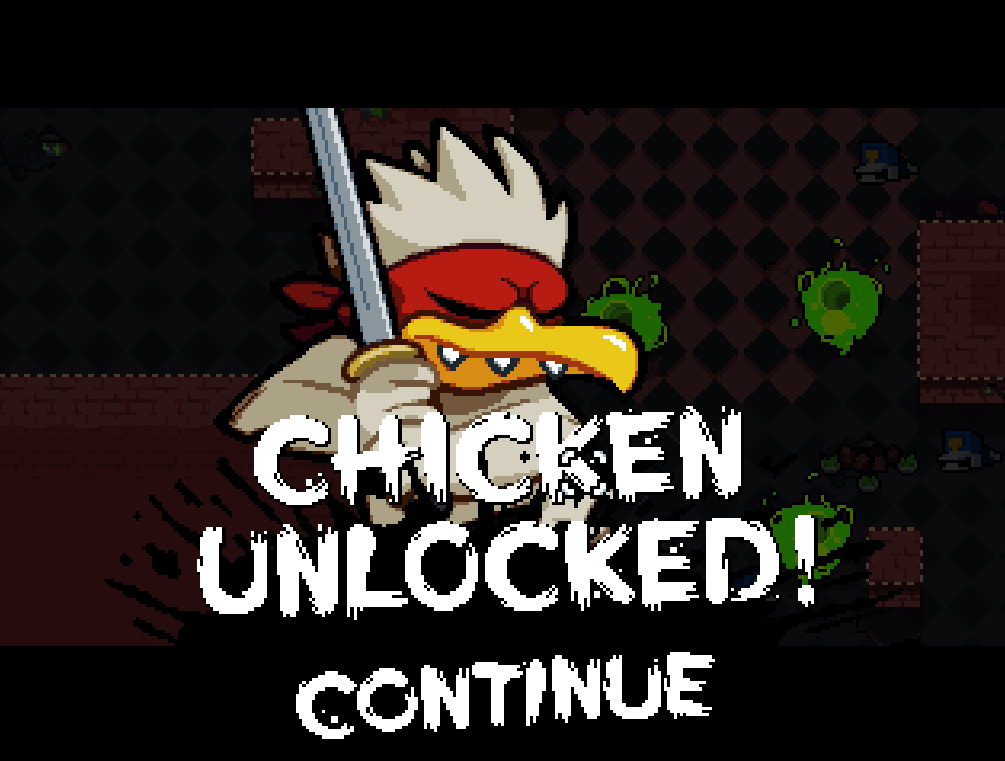
Some passive abilities can be double-edged. For example, Chicken cannot immediately die. Instead, the top half of her head falls on the ground, and becomes the center-point of the player’s camera view. Her body (and bleeding lower jaw) can still run around killing things for five seconds, hopefully coming across some healing items before she dies for good. Yet, with the camera view being static, the player is not likely to be able to do so if the remaining enemies are off-screen. More importantly, the ‘double-edge’ comes in the form of a semi-permanent reduction of two hitpoints.
The other example of double-edged passive abilities is Rogue’s ‘Blast armor’. When Rogue is hit, she emits a ring of small blue explosions around her, which inflict considerable damage on anything nearby – including explosive barrels that can kill her.
Then, there are passive abilities that only trigger at the end of levels, after the player character has gone through the warp portal. There is Horror’s extra option for mutations, and the healing that Rebel receives upon going through a portal.
As with its active ability, Eyes’ passive ability makes it the ‘odd one out’ for having powers that are much more situational than the others. It can “see in the dark”, unlike other characters (though not better by much), but not all levels are set in the darkness.
Finally, there is Frog’s passive ability – which is that it could not stay still. The player can only have him stop by using his special ability. He can take a lot to get used to.
MUTATIONS:
If the player character has gained any levels prior to entering a portal, the player gets to select one mutation for each level while the player character is being transported to the next location.
Mutations are generally permanent buffs. Some are straight overall upgrades, such as Rhino Skin that grants four additional hit points. These mutations are default go-to’s, unless the player has a game-plan.
Some mutations have more specific benefits that require the player to restrict his/her options. For example, there is a mutation that increases the damage output of energy weapons; obviously, the player character needs to use energy weapons in order to benefit from this.
Some mutations are there for non-offense utility, such as a mutation that lets the player character walk normally on all surfaces, effectively making terrain a non-issue.
Some mutations, due to the idiosyncrasies of the chosen player character, are quite useless. For example, mutations that trigger their effects upon the infliction of damage on the player character are useless on Melting, due to its fragility (unless the Rhino Skin mutation has already been taken).
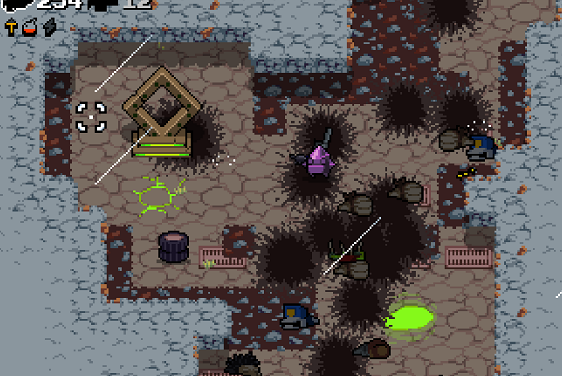
THRONE BUTT AND ULTRA MUTATIONS:
Most mutations are applicable to any character, but some have effects that are unique to specific characters.
The most notable of this is Throne Butt; its effect changes according to the character that took it. This usually bolsters the character’s special ability. For example, Melting’s corpse explosions become more powerful upon taking Throne Butt.
After reaching level 10, the player character can select one of two Ultra Mutations (three in the case of Horror). These Ultra Mutations are unique to the player character.
Some of these strengthen the player character’s special abilities further than Throne Butt does. For example, Throne Butt shortens Crystal’s transition animation to her fully crystalline state, but she is still immobile; one of her Ultra Mutations lets her move while she is in that state.
Some others enhance things that Throne Butt does not. For example, Fish rolls further with Throne Butt, whereas one of his Ultra Mutations lets him get even more ammo than he already does.
Yet some others grant completely different powers to the player characters. For example, one of Plant’s Ultra Mutations grants it the ability turn snared enemies into homing bombs after killing them.
The player character will not be getting any more mutations after the Ultra Mutation, however. The player will have to continue the playthrough with whatever he/she has selected, with next to no opportunity to reset his/her choices. (Melting does have an opportunity to do so, albeit it is very risky.)
AUTOMATIC AND NON-AUTO FIRE:
An observant player may notice that the control input for firing guns might not be consistent when using different weapons or even different player characters. This is actually the gameplay element of automatic and non-automatic fire; it is not particularly well explained to the player in-game.
Non-auto fire happens when the player has to repeatedly tap the control input for firing for a gun in order to fire repeatedly. Most weapons work in such a manner, likely to give the player some measure of control over ammo consumption. Then there is automatic fire. As long as the player keeps the control input for firing a gun held down, the player character continues to shoot.
Automatic fire is often applied on weapons that already have high rates of fire, but there are characters with abilities that turn non-auto guns into automatics; chief of these is Steroids. In the cases of weapons that require more finesse, like the crossbows, having been converted to auto, the player might want to consider deliberate individual presses of the control input instead of shooting them in auto.
GUNS:
Vlambeer and its staff have a silly infatuation with video game guns; they have been in almost of its games, right from the very first (Super Crate Box). It is thus no surprise that they are in Nuclear Throne too; there has not been any game with a post-apocalyptic setting that lacks guns anyway.
The guns are obtained as loot from chests; some enemies, such as the Giant Maggots, also drop them. Although guns are not spawned as often as the other things that the player character can grab, there are generally more guns than the player character can ever use.
The power of the guns scales according to the progress that the player has made in a playthrough. Getting closer to the Nuclear Throne causes more powerful guns to spawn. If the player manages to complete a playthrough and start a new “loop” (more on loops later), the guns that would come the player’s way are even more powerful.
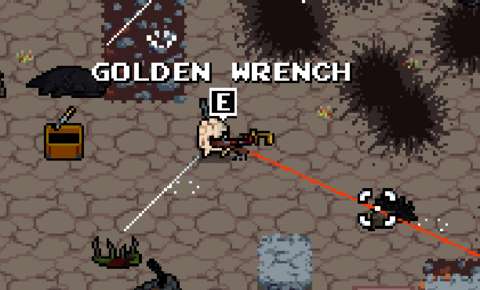
Indeed, it might be in the player’s interest to swap out earlier guns for later ones, though the player might want to do his/her homework on the statistics of the guns because the game lacks any in-game documentation on them.
GOLDEN WEAPONS:
Most player characters start with the regular revolver; they do not get to keep most weapons that they have found after they die. This is not the case for golden weapons.
Golden weapons are more powerful variants of regular ones. They only spawn regularly after the player has achieved a playthrough ‘loop’, but there is a way to get it earlier: getting into Y.V.’s mansion, which is guaranteed to have at least one Golden weapon.
There are more powerful weapons to be had, of course, but the main reason to get Golden weapons is that they are the only ones that can be retained from a playthrough that has been ended. The condition for this to happen is that the player character must end a level with a golden weapon, after which the golden weapon becomes an alternative weapon for the player character’s starting weapon.
PLAYING AS FROG:
Frog is not exactly a selectable player character. The player can start a playthrough with him, of course, but the condition for using him involves a Golden Weapon: the Golden Frog Pistol. This weapon is particularly challenging to obtain, since it involves looping a playthrough at least once.
Any character that has obtained the Golden Frog Pistol as a starting weapon cannot actually use it; instead, the character is replaced with Frog if the player chooses the Golden Frog Pistol as the starting weapon. The player can, of course, play with the intended character by switching back to the Revolver.
ULTRA WEAPONS:
After a ‘loop’ in a playthrough, the player character may already have achieved level 10. It may seem that rads would lose their value afterwards. However, rads can be used to power Ultra-class weapons.
Like Golden weapons, Ultra-class weapons are particularly powerful weapons that only regularly spawn after the player has completed a ‘loop’. To balance them gameplay-wise, they require both ammunition and rads to be fired.
For example, there is the Ultra Revolver, which fires bullets that are many times more powerful and faster than those fired by the regular Revolver. It also fires much faster and is automatic, meaning that it can also be used like a rapid-fire bullet-spewing gun.
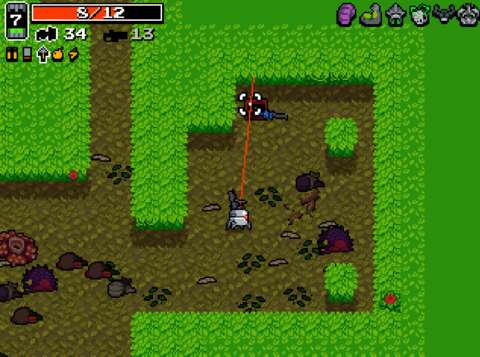
EXPLOSIONS:
With the word “nuclear” in its name, Nuclear Throne expectedly has plenty of explosions.
Explosions are mainly caused by explosives-using weapons, i.e. they are mainly caused by the player. There are a few enemies that can cause explosions, but they are very rare and their attacks can be seen coming.
It may seem like the player has a virtual monopoly on things that go boom, but it is not without a caveat: the explosions do hurt the player character, and they inflict so much damage that all it takes to end a playthrough is a screw-up in the player’s aiming and timing.
Explosions are the only things that can destroy wall tiles. This means that if the player has the ammunition to spare, he/she could “dig” an alternative path from one part of a level to another. On the other hand, this tactic could have been more viable if the player has some means of examining the entire layout of a level at any time; there is none.
BLOOD EXPLOSIONS:
There are some types of explosions that neither injure the player character nor destroy wall tiles. These are called “blood explosions” by fans of the game, because the most prominent examples of these explosions are those caused by Melting’s active ability. There are also a few weapons that inflict Blood Explosions; they happen to be much safer for a trigger-happy player to use. However, Blood Explosions do slightly less damage than regular explosions.
MELEE WEAPONS:
Nuclear Throne has melee weapons to offer too, if the player can put up with the disadvantage of not being able to kill enemies at range.
The most obvious benefit of using melee weapons is that they do not use ammunition. The other benefit is that the player character can deflect incoming enemy projectiles with well-timed attacks. Melee weapons also have considerable damage output.
Playing with a melee weapon is viable; after all, one of the player characters starts with one instead of a revolver. It is a completely different playstyle, however; switching between a melee weapon and a gun is even more challenging, requiring much practise.
NO TIME LIMIT FOR LEVELS:
There are quite a number of rogue-lite indies that insist on having mechanisms that keep the player moving and progressing, such as indestructible threats that spawn when the player character has lingered too long in a level. Nuclear Throne is not such a game.
This means that the player can choose to have cautious but time-consuming playstyles – which is just as well because there is a pervasive problem in the game.
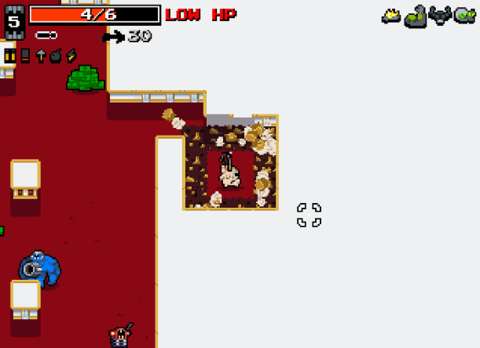
LIMITED VIEW OF LEVEL:
The main problem with the game is that the player has no way to examine the layout of a level. Furthermore, as each level is procedurally generated, the player cannot resort to memorization either. There is no mini-map too.
A good example of a contemporary rogue-lite indie to compare this game to is Crypt of the Necrodancer. That game has small procedurally generated levels that are populated with monsters, goodies and props according to the biomes that the player has reached, just like Nuclear Throne, but it has a mini-map that helps the player figure out where unexplored parts of the level are. (Granted, of course, Crypt of the Necrodancer puts a time limit on the player’s progress through a level.)
It is worth noting here that equipping one of the bolt-using weapons lets the player span the camera away from the player character, thus allowing the player to look further ahead. However, this does not address another issue, which is the line of sight of enemies; this will be described further later.
LEVEL TERRAIN:
Most levels have ground that does not contribute much to the gameplay, other than to provide visual contrast. There are some levels where different terrain types result in different sound clips playing, such as the concrete ground and the floor grates in the Sewers level, but they do not directly affect gameplay too.
However, a few levels and a couple of biomes do have terrain that affect the player character. For example, the Scrapyard levels have some wall tiles with fire traps that spew out flames that can injure the player character, but does nothing to enemies. (This can seem unfair, but it also means that enemies would not die and drop their loot where the player character cannot quickly reach.) As another example, the Crystal Caves have webs on the floor that can slow down the player character.
WARP PORTALS:
After the player has slain all enemies in a level, or triggered (often obscure) end-of-level conditions, a purple warp portal appears, usually close to where the player character is. (The narrative of the game is not entirely clear on why a warp portal is stalking the player character.)
The portal sucks in any lootable items nearby. If they happen to be ammo and rads, they are automatically added to the player’s counters, conveniently. In the case of weapons, they are brought to the next level and appear next to the player character where he/she/it spawns, which is also convenient.
If the player wants to backtrack through a level to search for any weapons that had been left behind, the warp portal would pose a hazard. If the player character gets too close to the portal and with momentum in the direction of the portal, the player loses control and the player character is sucked in.
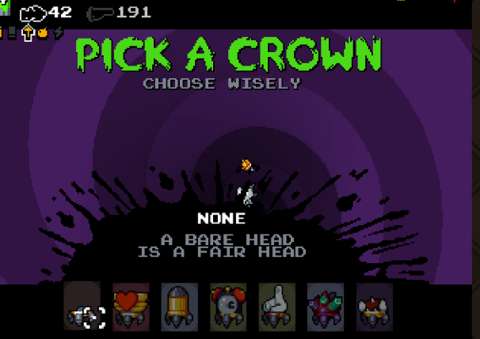
OTHER MEANS OF ENDING A LEVEL:
There are other means of ending a level, though they are initially obscure (at least to a player that did not check the wiki for the game, of course). Incidentally, these are ways to reach alternative levels, which in turn are needed to unlock certain player characters.
For example, there is a golden-trimmed car that can appear in the frozen biome levels. If the player character has a Screwdriver, he/she/it can hit the car to repair it (albeit with the paradoxical risk of damaging the car until it explodes). After it has been repaired, the player character can take the car to Yung Venuz’s mansion, which has its own set of monsters to kill and, as mentioned before, at least one golden weapon. In the case of this example, the part about repairing the car with a screwdriver can be rather obscure.
There are secrets that are easier to find. An example of these is the Proto Statue, which will absorb any rads that drop near it. After it has absorbed enough rads, it appears to be charged up, suggesting that it is ready for something, but there is no button prompt whatsoever. Of course, in the absence of button prompts, the only possible interaction that can be had with such a thing is to shoot it up; destroying the Statue happens to produce a different kind of warp portal. This portal brings the player to the only source of “crowns” in the game.
CROWNS:
Crowns are difficulty/reward modifiers. They are only ever found in the Vault of Crowns. The player can choose a crown upon leaving that vault, and that crown’s effects will be applied on the playthrough.
Crowns come with both benefits and disadvantages. For example, the Crown of Life – despite its name – has the disadvantage of nearly eliminating the possibility of small health kits being spawned. Rather, it has a high chance of converting a canister of rads into a large health kit.
Wise players would avoid picking any crown, if they somehow managed to get into Vault even if they did not want to. On the other hand, certain Crowns would be very useful to specific characters. For example, the Crown of Guns might be useful to Robot, because the crown causes more weapons to spawn, which in turn leads to more opportunities to make use of Robot’s ability.
ENEMIES:
There are plenty of things to shoot or swing at. All of them are comically hideous, and quite united in their intent to kill the player character.
There are the mummy-like Bandits, which, interestingly, appear just about everywhere. They are push-overs, but there are many of them and all of them are armed.
Most enemies are, however, endemic to the biome of the level. For example, maggots only appear in the desert levels, rats only appear in the sewers level and crystal monsters only appear in the Crystal Caves. Encountering them for the first time can be worrisome, especially if the player has not studied about their capabilities. Fortunately, practice (and dying repeatedly) makes perfect.
Some enemies happen to drop things when they die. The armed ones, in particular, have a high chance of dropping loose ammo, and a small chance of dropping guns.
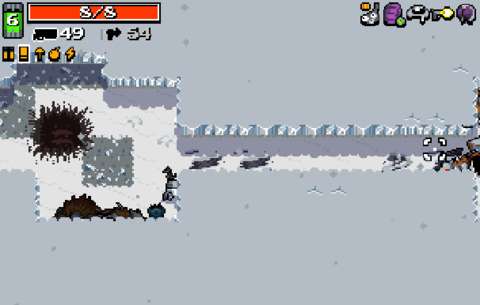
I.D.P.D. GOONS:
There are enemies that look like cops and appear out of blue warp portals. Like the other enemies, they intend to kill the player character. However, they do have advantages that make them a step above other enemies.
Some of them can do combat rolls like Fish can, and their Shieldwardens can turn themselves into crystalline pillars, like Crystal can. They do not drop rads (unless the player character is Melting) and do not count towards the conditions for the appearance of the end-of-level portal.
All of these make them much less worth fighting than other kinds of goons. Nevertheless, they appear as the most numerous enemies in the Palace region.
ENEMIES’ LINE OF SIGHT:
Enemies do not start a level aware of the player character’s location. Enemies who are not aware of this have distinctive idle animations and if they are armed, their guns are aimed skywards.
However, after they spot the player character, they go into a state of alert and their guns will always be pointing at the general direction of the player character. They also know the general whereabouts of the player character, though only a few types of enemies actively pursue the player character; most are content to linger where they are.
As for how they spot the player character, all they need is a clear line of sight to him/her/it, at least a length of two screens away. This means that they can already shoot at the player character even though the player cannot see them.
There are audio cues if they happen to fire while off-screen, thus giving the player time to look for incoming projectiles. In the case of enemies that fire very fast projectiles, such as the robotic snipers, there might be visual cues like visible laser sights crossing the player character’s path while they take time to aim. Of course, such warning signs are more useful if the player is not already preoccupied with eliminating threats that are much nearer.
Ultimately, the most effective ways to defeat off-screen enemies is to learn to dodge their shots like the player would in bullet-hell shooters, while locating and shooting them based on their projectiles’ trajectories. This is easier said than done, and considering that loot from enemies can disappear, there is a disincentive to do this.
BOSSES:
At the last level of every biome, and in biomes that just consist of one level each after having completed a loop, there is a boss that has to be fought.
Typically, these bosses have considerable firepower and toughness, far beyond goons. The first boss, Big Bandit, is the most notable example because he is always the first boss to be encountered in every playthough. Compared to the relatively weak enemies in the Desert biome, he can be a lot to deal with if the player has not obtained a powerful weapon. Taking cover does not help much, because he can crash through wall tiles if the player character hides for too long.
The later bosses would have similar advantages: considerable firepower and the ability to destroy wall tiles one way or another. The later bosses have much more complicated projectile patterns, however, which further necessitate the possession of skills that one would need for playing bullet hell shooters.
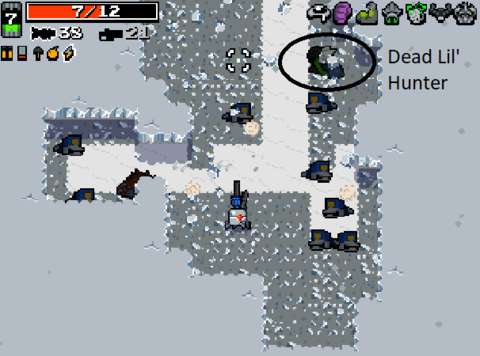
Most of the bosses are manageable, because they do not move in erratic manners. The only exception to this is the mad Lil’ Hunter, whose jetpack allows him to launch into the air and land with devastating force wherever he pleases.
Usually, he attempts to land near the player character; even if the player character dodged this, any cover that is near the boss is destroyed. The other bosses destroy cover too, but only those in their movement path; Lil’ Hunter is not limited by this. Even if Lil’ Hunter did not land near the player character, he might land at a location that is problematic to the player, e.g. any cover that protects the player character from him does not protect him/her/it from any other enemy.
(Incidentally, in the wiki for the game, Lil’ Hunter gets the most complaints from players.)
LOOPS:
A playthrough can either end in death or end with the player character sitting on the titular Nuclear Throne. However, the player can choose to continue the playthrough, if he/she knows the conditions to do so. (These conditions have to be fulfilled during the fight with the Nuclear Throne, however. Of course, the Nuclear Throne itself is a boss.)
Having done so, instead of sitting on the Throne after defeating it, the player character goes through a warp portal that appears. The player is shown the fate of the other player characters, and is then forced into another boss fight. Overcoming this one sends the player into another ‘loop’ in the playthrough, sending the player through the same sequence of levels again.
There are differences though. Firstly, there are a lot more enemies, there are more powerful enemies and there are more bosses. To compensate for the increased challenge, the weapons that are spawned are more powerful (namely the aforementioned Golden and Ultra weapons). New bosses appear too, such as bosses for the single-level Sewer and Crystal Cave biomes.
CO-OP:
Single-player is already hectic; co-op is even more so. In the official version of the game, co-op can only be local. This is just as well because both players have to share the same screen. The camera also will not split to accommodate long distances between the two players.
Considering the issue of not being able to see far ahead of the player character, this means co-op is only for seasoned players of Nuclear Throne.
Anyway, things work a tad differently in co-op. Firstly, both players share the rad pool and character level, and they have to decide unanimously on which mutation to take. Furthermore, the Ultra Mutations are replaced with two mutations that affect their survivability.
However, they have different ammo counts and health counters. This means that they have to share loot drops from enemies and chests. In a game as hectic as this, these two players will need to have considerable trust in each other for such resource management.
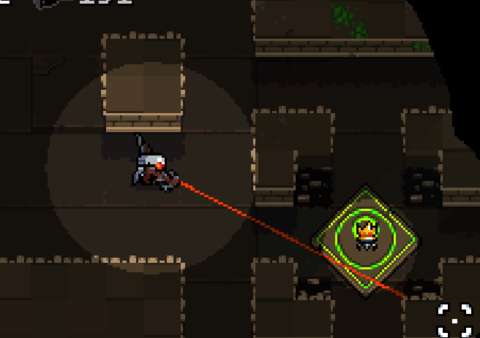
Perhaps the most significant difference is that a player character does not stay dead when his/her/its HP is reduced to zero. The other player character, if he/she/it is still alive, can revive the other by giving away half of his/her/its remaining HPs; obviously, this cost is there to avoid abuse of this feature. Furthermore, the other player character cannot take the time to clear the area of any threat before reviving the downed player character; he/she/it will gradually lose hit points and can eventually die.
(As for the matter of there can only be one who sits on the throne, the first player always takes precedence. There is no duel to the death for the two players.)
VISUAL DESIGNS:
Having been made using the GameMaker engine, Nuclear Throne understandably has not much in the way of graphics to offer. The sprites for the player characters are simplistic square blobs mashed together and armed characters even lack actual arms; their guns merely float on top or behind their sprites. On the other hand, their animations have plenty of frames that emphasize their characteristics.
Levels in the game are composed of gaps that have been cored out of otherwise solid layers of wall tiles; this gives a comical impression that the habitable parts of the post-apocalyptic world in Nuclear Throne are no more than pits on its surface or cavities in its underground.
There are better attempts at presenting the post-apocalyptic appearance of the setting. There are broken vehicles lying about in the Scrapyard biome, and barrel fires around which Bandits huddle as a sign of their need for warmth. Yet, there is not much that implies anything about the state of the world prior to the apocalypse, which could have made for a richer backstory.
There are plenty of particle effects, many of which are implemented using layers (something made possible by latter-day GameMaker engines). This allowed for animations like dust clouds blowing away behind the player character as he/she/it runs. There are subtler visual designs too, such as the warp portal appearing like an eye that is always looking at the player character.
There is hand-drawn artwork; this is used to depict characters in the character selection screen, the appearance of bosses and the illustrations for mutations. Most of them have been strained through pixelation filters though, and some of the results do not look particularly recognizable. For example, the illustration for Throne Butt is showing Crystal checking out her comically curvaceous butt, but it also looks like a mangled- and bruised-up face (especially if the player is not already aware of what the illustration is showing).
SOUND DESIGNS:
The gibberish language that is “Trashtalk” is the very first thing that the player hears when playing the game. It can be very jarring; even after the player has discovered that the gibberish that is uttered is an actual made-up language (with barely serviceable sentence structure and grammar), it can still sound jarring. This is because every character has qualities to their voices that are so different such that a specific Trashtalk phrase can sound different from one character to another.
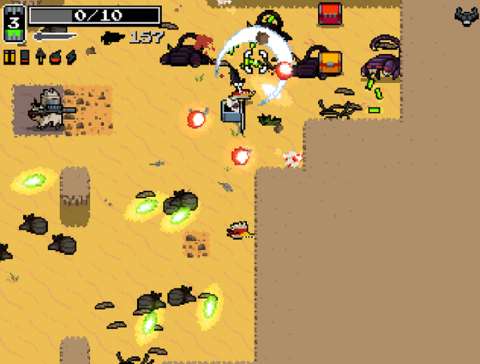
Nevertheless, that the gibberish is a language still imparts a bit of charm to the game.
The player character’s guns are a noisy bunch: rapid-fire weapons chatter or thump away, depending on their calibre; energy weapons have crispy zings; crossbows have satisfying whips as they release their bolts; melee weapons have hefty audible swings, et cetera. Yet, none of them will be too loud such that more important sound effects cannot be heard. These important sound effects are of course the sound clips that are associated with the attacks of enemies; by default, they are loud enough to be heard over anything else.
Then, there is the music, composed by Jukio "Kozilek" Kallio, who had worked with Vlambeer in the past (such as the music in Gun Godz). Each of the biomes has its own soundtrack, which usually sounds melancholic and which plays when there are not too many things happening on-screen.
However, after the player raises a ruckus and draws the fire of many enemies while firing back, the music subtly switches to another track that is more energetic. The only times when the music has a sharply noticeable transition is when bosses appear, after which the tracks that are associated with the bosses play.
NUCLEAR THRONE ULTRA MOD:
Nuclear Throne has a considerable enough following among fans that there is an ambitious project to implement more content and gameplay elements via modification of the game. Understandably, this is called the “Ultra” mod.
At this time, there is plenty of content in that mod that is not in the main game, such as a character that is very likely a reference to the Viking lass in Rayman: Legends. Much content in the base game has also been reworked. For example, Frog is a selectable playable character of his own and one of his Ultra Mutations removes his always-moving tendency.
CONCLUSION:
Nuclear Throne may not make the best of first impressions, but it has a peculiar charm that slowly but surely comes to the fore (though it could have done so earlier to its betterment). There is considerable complexity in its gameplay elements, down to even types of explosions, to recite an example. Most importantly, its gameplay rewards skill and familiarity; with enough patience and tenacity, it is possible for the player to experience most of its content.
Yet, there is the issue of the player not always having the convenience of examining the layout of a level. There are means of looking ahead, but these are restricted to a specific category of weapons. Meanwhile, enemies can spot the player character from further away, and start attacking even before the player has seen their sprites.
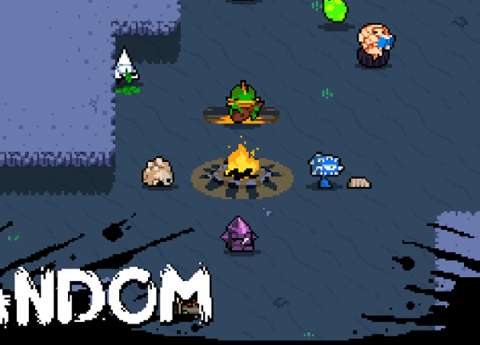
Both of these issues can be manageable with cautious playstyles, but for anyone with less patience, this puts them at the mercy of the procedural generator for level layouts and placement of enemies. Again, the player could overcome these with enough tenacity, but that’s a special kind of bull-headedness that not everyone has.

